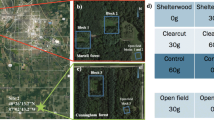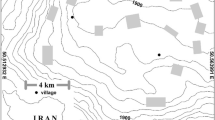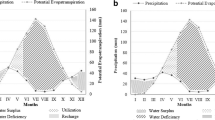Abstract
A small scale agroforestry study which was begun in 1952 was revisited in 1985 to evaluate the long-term influence of site preparation and grazing on tree growth and survival in a Douglas-fir (Pseudotsuga menziesii)-white oak (Quercus garryana)-sheep silvopastoral system. In 1952–1953, two-year-old Douglas-fir seedlings were planted at the rate of 2500 trees/ha under three levels of site preparation: (1) no treatment, (2) oak thinned by 50%, and (3) oak clearcut. From 1954 to 1960, yearling ewes grazed one-half of each of the three thinning treatments for 3–4 weeks each spring. The conifers have been undisturbed since grazing was discontinued in 1960. Survival of planted conifers averaged 64% in 1985 and did not vary among either site preparation or grazing treatments. From 1964 to 1985, trees on the thinned and clearcut plantations grew an average of 1060 and 990 cm in height, respectively, compared to 900 cm on the unthinned plantation. Diameter at breast height (dbh) averaged 3.8 and 5.6 cm greater on thinned or clearcut plantations, respectively, than on the unthinned control by 1985 (p < 0.05). Conifers on grazed plantations had increased height and dbh growth during the first 12 years of plantation life, averaging 63 cm taller (p < 0.10) and 0.7 cm greater in dbh (p < 0.05) than the ungrazed plots by 1964. By 1985 the difference in height (122 cm) and dbh (1.0 cm) between grazed and ungrazed plantations was not statistically significant. These data suggest that although site preparation can positively influence conifer growth, total clearfelling is no better than thinning oaks. Furthermore, proper grazing can increase height and dbh growth of the conifers during and immediately after the grazing years.
Similar content being viewed by others
References
Doescher PS and Alejandro M (1985) Cattle and establishment of conifer seedlings: Preliminary findings for southwest Oregon. In: 1985 Research in Rangeland Management, pp 7–10. Oregon Agricultural Experiment Station Special Report 743
Hall FC, Hedrick DW and Keniston RF (1959) Grazing and Douglas-fir establishment in the Oregon white-oak type. Journal Forestry 57: 98–103
Hedrick DW and Keniston RF (1966) Grazing and Douglas-fir growth in the Oregon white-oak type. Journal Forestry 64: 735–738
Krueger WC and Vavra M (1984) Twentieth-year results from a plantation grazing study. In: Research in Rangeland Management, pp 20–24. Oregon Agricultural Experiment Station Special Report 715
Leininger WC (1984) Silvicultural impacts of sheep grazing in Oregon's Coast Range. Ph.D. Thesis, Oregon State University, Corvallis, Oregon, USA 203 p
Reid R and Wilson G (1985) Agroforestry in Australia and New Zealand. Goddard and Dobson, Victoria (223 p)
Soil Conservation Service (1975) Soil Survey of Benton County Area, Oregon. United States Department of Agriculture, Washington, DC
Sprague FL and Hanson HP (1946) Forest succession in the McDonald Forest, Willamette Valley, Oregon. Northwest Science 20: 89–97
Steel RGD and Torrie JH (1980) Principles and Procedures of Statistics. Second edition. McGraw-Hill Book Company, New York
Author information
Authors and Affiliations
Rights and permissions
About this article
Cite this article
Jaindl, R.G., Sharrow, S.H. Oak/Douglas-fir/sheep: A three-crop silvopastoral system. Agroforest Syst 6, 147–152 (1988). https://doi.org/10.1007/BF02344751
Issue Date:
DOI: https://doi.org/10.1007/BF02344751




